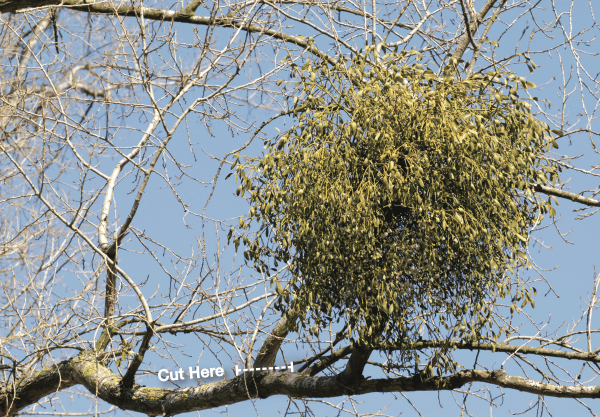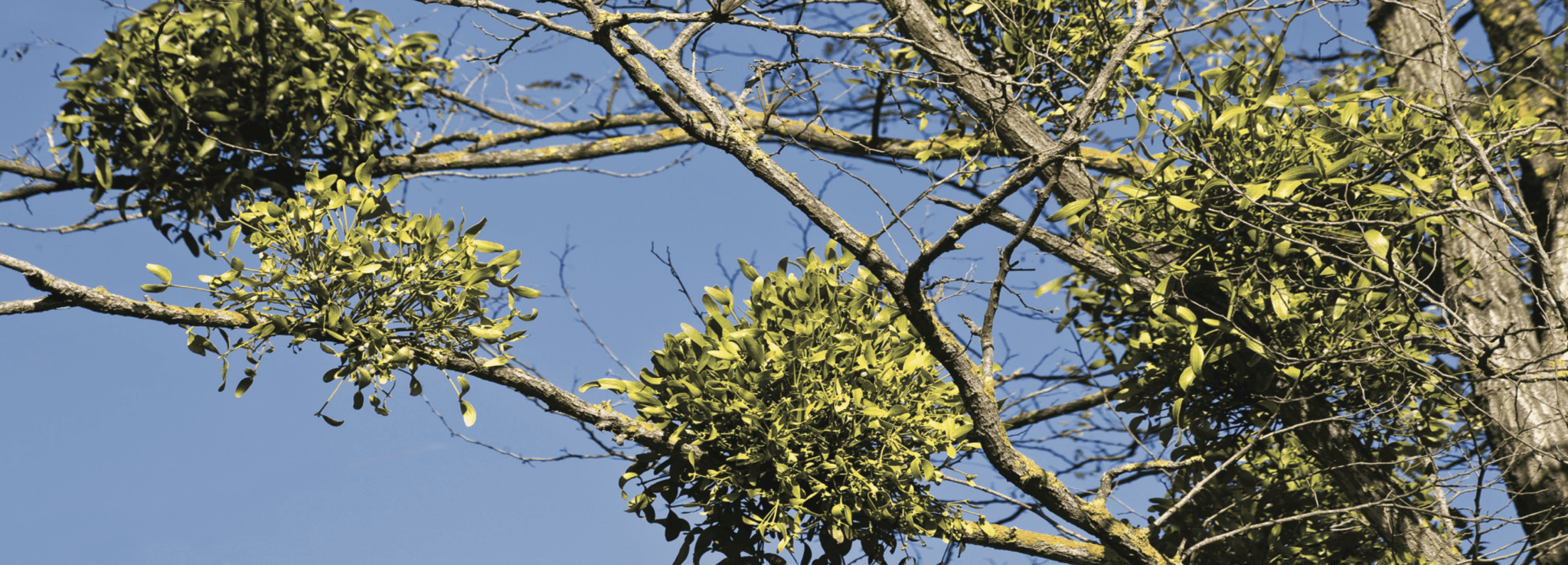Forestry

Mistletoe is not usually thought of until it’s a holiday decoration. This odd plant has a long tradition of romantic, fertility, magical, and even diplomatic uses. For example, standing beneath mistletoe on a field of battle allowed Celtic warriors to rest, free of the fight.
Despite its traditional uses, mistletoe is actually poisonous to people. Eating mistletoe can cause gastrointestinal problems such as cramping and diarrhea. Compounds in the mistletoe can also slow the human heart. It’s easy for humans to avoid mistletoe poisoning—just don’t eat it. But for trees, mistletoe is a thief that will disfigure and potentially kill it. Several species of mistletoe are found in the United States and throughout the world. Mistletoe is fairly picky about the trees it inhabits. In Alabama, the most common species is the American oak mistletoe (Phoradendron serotinum), which frequently attacks oak trees but also attacks pecan, hackberry, elm, cherry, and sycamore trees.
American oak mistletoe and other rare species of mistletoe commonly infest many landscape trees. This generally happens when these trees are stressed. In fact, mistletoe infestation is often a good indicator of a stressed or unhealthy tree.
Biology of Mistletoe
Mistletoe is common throughout Alabama and is usually noticed only when deciduous trees lose their leaves for winter. At that time of year, mistletoe stands out, being the greenest part of the tree canopy. Because mistletoe has leaves of its own, it is called an obligate hemiparasite. Obligate because it doesn’t grow in the earth and must have a host tree to live on, and hemiparastic because it doesn’t completely depend on the tree for its entire livelihood as a true parasite does.
Mistletoe is a plant and is spread by seed like any other plant. The mistletoe fruit is a white berry that is very sticky when broken. This stickiness allows the seed to cling easily to birds, squirrels, and trees. Germination is much like that of any other plant, but mistletoe roots aren’t roots. Mistletoe has rootlike structures called haustoria that grow into the tree’s sapwood. The haustoria absorb the tree’s water, nutrients, and sugars directly from the sap stream, creating a blockage in the tree’s system.
As the haustoria grow, the tree reacts with additional growth around the haustoria. Infested branches and trunks develop swollen areas around the mistletoe in an attempt to stop the mistletoe and resume unobstructed flow of sap and water.
Damage
Because we know that mistletoe grows best on stressed and weakened trees, it comes as no surprise that trees growing in cities and lawns are often infested. Our built environments (cities, suburbs, etc.) stress trees, making them susceptible to mistletoe infestation. Common stresses trees endure are soil compaction, shallow soil, rocky soil, poor drainage, poor fertility, and even root loss from digging or trenching.
The initial growth of mistletoe in a new infestation is slow and does little to the tree. Later—generally, years later—the mistletoe reaches a size that requires so much from the tree that branches beyond the infestation begin to die off because of lack of water. Often, the tree reacts to the mistletoe as if it were a disease or insect. The tree closes off the damaged portion of itself in an attempt to contain the problem, leading to more dead branches.
Whole trees rarely die of mistletoe but rather of many problems together, mistletoe being only one of them. As the amount of the tree infested with mistletoe increases, the tree becomes more and more stressed, allowing additional problems to develop. Common secondary problems associated with mistletoe are diseases and pests taking advantage of the stressed tree. Hypoxylon canker and ambrosia beetles are good examples.
Because of this scenario of mistletoe helping along other problems in the tree, the sooner you manage mistletoe, the better your chances of preventing tree disfigurement and death.
Control
Base your decision to control mistletoe on the amount of mistletoe in the tree, how long the mistletoe has been there, and the amount of stress the tree is showing.
Improving Tree Health
The healthier your tree is, the better it can resist becoming infested with mistletoe or resist the mistletoe already in it. Good tree management always begins with creating the least stressful conditions possible for tree growth—good, uncompacted soil with proper levels of minerals, organic matter, and water.
Mulching around trees helps achieve many of these desirable conditions at minimal cost while benefiting the tree’s health. Apply mulch in a 3-inch thick layer over as large an area as possible. Completely mulching the area under the drip line of the tree is a starting point. Don’t pile mulch against the trunk as that would encourage other problems.
Pruning

Figure 1. When pruning out mistletoe, cut back to the branch collar or to a secondary branch to help the tree recover.
If mistletoe is already established in a tree, the most common control option is pruning it out. In small trees or infestations growing close to the ground, anyone can simply cut the mistletoe off the tree. However, because the haustoria are still inside the tree, mistletoe is likely to regrow. Complete control only happens when all the mistletoe, both inside and outside the tree, is removed.
To completely remove mistletoe, prune at least 6 inches below the spot the mistletoe branches are growing. When removing branches, cut back to the branch collar or to a secondary branch to help the tree recover from the removal (Figure 1). See Extension publication ANR-0258, “Pruning Ornamental Plants,” for more information.
It is also important not to over-prune your tree. The most common advice is to remove no more than 20 to 30 percent of a young, healthy tree’s canopy in a single year. If the tree is mature or unhealthy, remove no more than 10 percent of the canopy in a single year. Mistletoe removal may have to be spread over a few years to ensure that your tree recovers well.
Removing Whole Trees
Occasionally, a tree may have a severe mistletoe infestation combined with declining health that makes complete removal the best option. No clear guideline determines if you should control the mistletoe or remove the tree. The following criteria may help you decide:
How much of the tree is covered in mistletoe?
A tree with mistletoe covering 30 to 50 percent of its branches will require severe pruning, even spread over a few years. Without large parts of its canopy, the tree will not be able to make as much energy, resulting in slow wound closure that, in turn, leads to decay within the tree and an open invitation to diseases and pests.
How healthy and vigorous is the tree?
An older, overmature tree or a tree in poor health will only be able to handle minor pruning. At best, a heavy mistletoe infestation would require many years to overcome at repeated cost to the owner. Also, if the tree is in poor health, it may already be suffering from other problems that mistletoe control would make worse. For unhealthy and older trees with heavy infestations (more than 30 percent of the limbs infested), removal is the better option unless the costs of multiyear controls and treatments for tree health can be justified.
Arnold M. Brodbeck, Extension Specialist; Jack Rowe, Regional Extension Agent; both with Auburn University, and Gary Ickes, Ickes Tree Service
Reviewed March 2023, Controlling Mistletoe in Trees, ANR-1454

